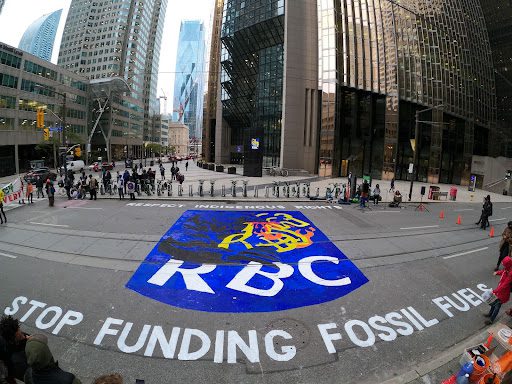New analysis from InfluenceMap’s FinanceMap platform of the 2020–2024 lending and underwriting of the ‘Big Five’ Canadian banks — Royal Bank of Canada (RBC), TD Bank, Scotiabank, Bank of Montreal (BMO), and Canadian Imperial Bank of Commerce (CIBC) — reveals that these banks show persistent high exposure to the fossil fuel sector.
Ten years on from the ‘Tragedy of the Horizon’ speech given by then governor of the Bank of England Mark Carney, this research shows that the Big Five Canadian banks still do not appear to be considering the ‘transition risk’ Carney identified as one of the key ways climate change threatens financial stability.
“This report confirms that Canada’s big banks are not just lagging on climate action, they are actively contributing to the acceleration of the climate crisis,” Stand.earth Climate Finance Director Richard Brooks said. “They are making riskier bets than their European and even American counterparts — not only jeopardizing our economy but also actively slowing the transition to clean energy. The recent wave of catastrophic fires and floods should be a final warning. This data is a blaring call for stronger financial regulation to end this reckless gamble with our future.”
Significantly, the five largest banks’ fossil fuel exposure is predominantly to Canadian oil and gas producers that are less cost-competitive than other producers globally. This exposes banks to higher financial risk in a net-zero transition, as declining oil and gas demand drives prices down. The banks also have limited financing to green companies, with a green-to-fossil-fuel financing ratio substantially below that achieved by top European banks. Taken together, this leaves the Big Five Canadian banks significantly more exposed to elevated financial risks associated with the energy transition than their global peers.
This report finds that Canada’s five largest banks were three times more exposed to the fossil fuel sector in 2024 than their top European peers, and more than twice as exposed as their largest counterparts in the U.S. The Big Five Canadian banks provided $131 billion (USD) in financing to fossil fuel companies, accounting for 18.3% of their total financing portfolios, compared to 6.0% for European banks and 7.8% for US banks. This pattern of far higher relative exposure among Canadian banks has been consistent over the last five years.
In 2024, the Big Five averaged just $0.21 in green financing for every $1 in fossil fuel financing, substantially below the 0.68:1 ratio achieved by top European banks. This places Canada’s largest banks far off track to reach a 4:1 green to fossil fuel financing ratio by 2030, estimated by BloombergNEF to align with a 1.5°C scenario.
CIBC had the highest relative exposure to the fossil fuel production value chain in 2024, at 24.1% of its total portfolio, but the lowest absolute financing, at $21 billion. In contrast, RBC had the lowest relative exposure, at 13.4%. TD Bank had the highest absolute fossil fuel financing deal value at $36 billion.
FinanceMap’s March 2024 report, Canada’s Big Five Banks: Heading to Net Zero?, found that despite setting net-zero commitments, Canada’s five largest banks were undermining their own climate targets through their financing activities, lack of robust sector financing policies, and inconsistent government policy engagement. In January 2025, all five banks left the Net Zero Banking Alliance, further drawing into question their previous climate pledges. This report provides an update to FinanceMap’s analysis of the Canadian Big Five banks’ financing flows by including financing deal data up to the end of 2024 for all five banks.
